The Plextor M6V (256GB) SSD Review
by Billy Tallis on October 12, 2015 8:00 AM ESTSequential Read Performance
Just like the random read test, sequential reads are tested across the span of a full drive and a representative sample of queue depths. Most operations involving large files (typically images and videos) fall under this test's purveiw, but streaming or playing even the highest resolution videos won't be a challenge for any of these drives. Copying files to another SSD or loading a new level in a video game would be more likely to show noticeable difference from better performance here.
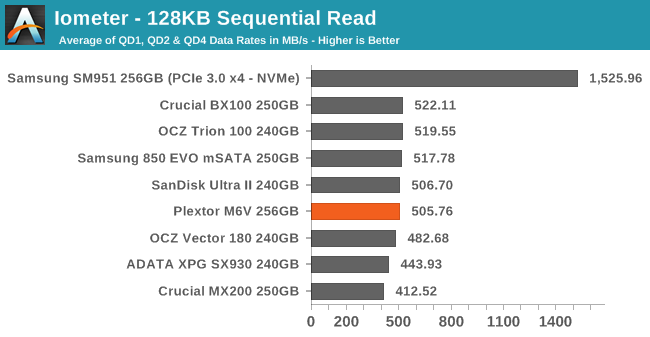
The SATA interface's speed limit determines almost everything in this graph. Almost all drives, including the M6V, are close enough that the differences hardly matter.
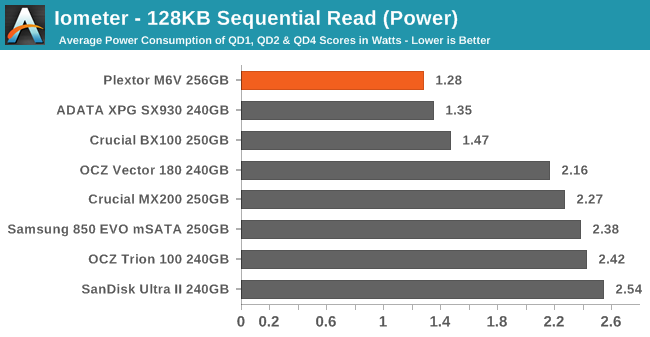
On the other hand, power consumption varies considerably. The TLC drives are at the bottom as usual, and the M6V is at the top with only a little bit of competition.
 |
|||||||||
| Default | |||||||||
The queue depth scaling reveals the source of the variation in the averages above. The only drives below the M6V in performance are the ones that can't hit the limit at a queue depth of two, and the drives above the M6V all have better QD 1 performance.
Sequential Write Performance
The sequential write isn't limited to a small span of the disk, as that usually doesn't make a difference for this performance metric. As always, our averages are of the lower queue depths, but scaling to higher queue depths is also investigated. Bulk file copies and recording uncompressed video are the kind of uses that depend on sequential write performance.
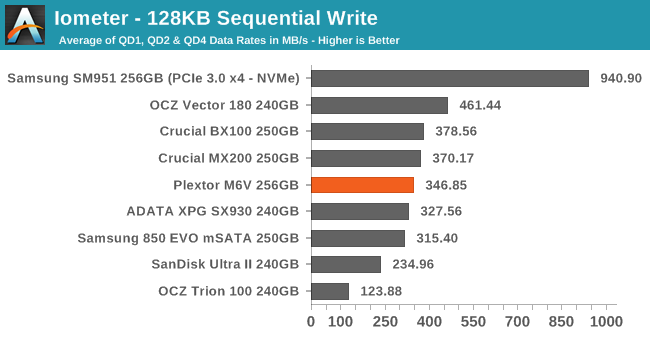
The M6V is back in the middle of the pack, and none of the SATA drives of this size are quite able to reach the limit of the interface.
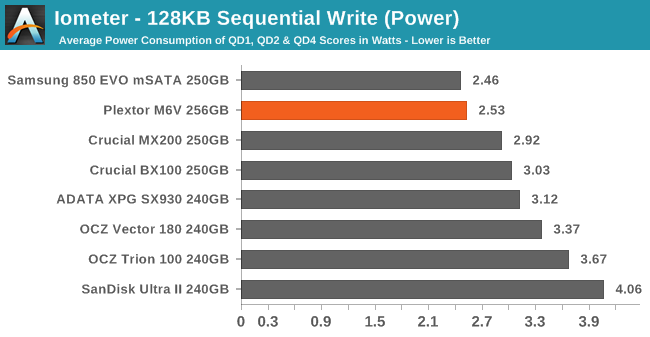
The M6V doesn't quite take first place for power consumption, but it comes within spitting distance of the surprisingly efficient Samsung 850 EVO.
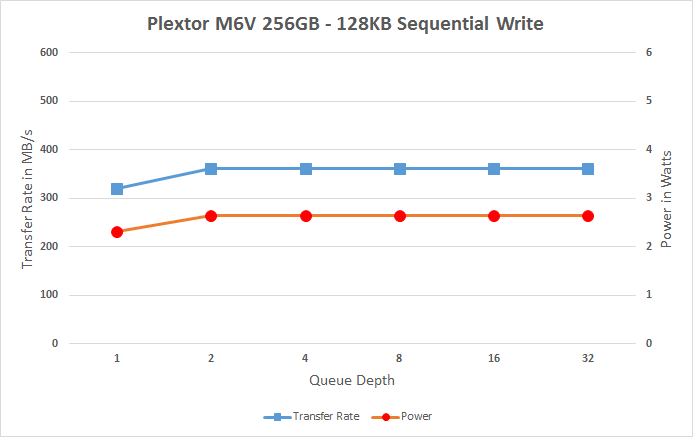 |
|||||||||
| Default | |||||||||
Most drives have flat performance across this test, indicating that a 128kB block of data is already large enough for the drive to extract all the speed it can.










51 Comments
View All Comments
eddieobscurant - Monday, October 12, 2015 - link
when is the samsung 950 pro review coming up?Billy Tallis - Monday, October 12, 2015 - link
Soon.I wanted to start with a more straightforward and predictable review to make sure I had the test rig set up correctly. The 950 Pro review calls for some deeper investigation than this one, since it's the first real mainstream consumer NVMe drive and there are custom drivers and stuff like that to investigate.
coolhardware - Tuesday, October 13, 2015 - link
Sweet action, looking forward to it! :-)Coup27 - Tuesday, October 13, 2015 - link
Billy when you do the review for the 950 Pro would you be able to do a couple of paragraphs recapping over SATA Express, PCI Express, M.2, U.2 and anything else related to it? I've half kept up to date but I don't think they've done a great job of keeping it clear either.Xichekolas - Wednesday, October 14, 2015 - link
Mind having a section on Linux support/compatibility/etc in the 950 review? When you say "custom drivers and stuff like that to investigate" it makes me dread the buy-new-product-wait-a-month-for-kernel-support routine.Billy Tallis - Wednesday, October 14, 2015 - link
As I understand it, the custom drivers for NVMe is a thing everybody is doing to get around the limitations of Microsoft's driver, like not being able to send administrative commands to the drive (including the equivalent of secure erase). At least some of the features of Samsung's SSD Magician software will probably require their NVMe driver. I have yet to encounter a custom NVMe driver for Linux, only vendor-specific management tools.Anyways, the 950 Pro review's section on compatibility will be as thorough as I have time and resources for. I've done some work to equip our testbed to measure PCIe power consumption for the first time, which means I really should re-test the SM951 and XP941 for comparison's sake.
Cliff34 - Monday, October 12, 2015 - link
Thanks for the review. But it seems like these days if the SSDs cannot differentiate themselves either in price (cheaper the better), speed (faster the better) and reliability (the longer the better), there's very little incentive to buy a SSD that's somewhere in the middle.If you want value, get the BX100 (or one that's on sale) or if you want speed, get the Samsung 850 Pro or the Sandisk Extreme Pro.
zodiacfml - Monday, October 12, 2015 - link
Even Intel/Micron isn't sure if they can compete with Samsung.MagickChicken - Wednesday, October 14, 2015 - link
So am I right in thinking that this generation of consumer-grade SATA SSDs operates roughly 50% better than my current SSD, the Vertex 3?http://www.anandtech.com/show/4256/the-ocz-vertex-...
Seems like there'd be a higher increase in performance over four years considering how new the market was in 2011, though I'm certainly not going to knock the 50-60% drop in $/GB. Or is there a more significant change in the benchmarks that I'm not picking up on?
Billy Tallis - Sunday, October 18, 2015 - link
Some of the benchmark metrics are simply hitting SATA limits on bandwidth and latency. Others are constrained by the limited parallelism of interactive I/O, so the fundamental performance limits of NAND flash are showing through.Also keep in mind that pretty much all NAND production advances have been used to drive down cost, not to improve performance or reliability. We could be making SLC that's cheaper than the MLC used in early SATA SSDs, but the market prefers increased capacity and that's why we have TLC drives now and complicated slow error correction methods to keep them mostly working.